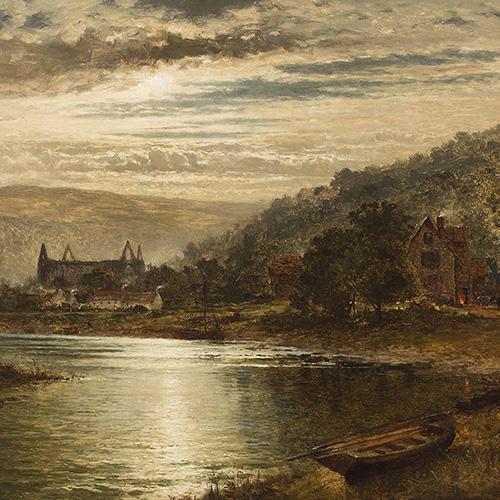

One of the most gifted and popular landscape artists of his era, Benjamin Williams Leader (1831-1923) made his reputation capturing a rural idyll rapidly disappearing amid the relentless onslaught of the industrial revolution.
Born in Worcester, Benjamin was the third of eleven children born to civil engineer Edward Leader Williams and his wife Sarah. A keen amateur artist and collector, Edward organised an exhibition of Modern British Art at the Worcester Atheneum in 1934, which would have a lasting impact on his young son.
The exhibition included a number of works by celebrated landscape painter John Constable who stayed at the William’s family home, Bromwich Villa, and would become a formative influence on young Benjamin. Encouraged by his father, whom he would accompany on sketching trips in the nearby Worcestershire countryside, Benjamin soon developed a passion for painting.
Leader’s formal education was conducted at the Government School of Design in Worcester, where his contemporaries included the sculptor Sir Thomas Brock, and pottery designers Charles Noke of Royal Doulton and James Hadley of Royal Worcester Porcelain.
 He later studied art at the Worcester School of Design, while working for his father as a draughtsman, before enrolling in the Royal Academy Schools in 1854. Success came quickly for Benjamin who had a picture accepted for exhibition in his first year at the academy. Remarkably the genre painting, entitled ‘Cottage children blowing bubbles’ sold to an American collector for £50, which today would be worth just shy of £7,000.
He later studied art at the Worcester School of Design, while working for his father as a draughtsman, before enrolling in the Royal Academy Schools in 1854. Success came quickly for Benjamin who had a picture accepted for exhibition in his first year at the academy. Remarkably the genre painting, entitled ‘Cottage children blowing bubbles’ sold to an American collector for £50, which today would be worth just shy of £7,000.
In 1856 he was advised to change his style from domestic and genre themes to landscape painting following an important sale to the artist Frederick William Hulme. The following year he also changed his surname from Leader Williams to Williams Leader, in order to distinguish his work from that of the famous Williams family of landscape artists.
Benjamin opted to leave his studies with the Royal Academy since he was already enjoying considerable commercial success, due in no small part to the patronage of London art dealers Thomas Agnew and Thomas Wallis. Indeed, the pair purchased so much of Leader’s work that by the early 1860s very few of his paintings even made it to public exhibition.
 Throughout this period Leader found his subjects on the banks of his beloved River Severn, returning time and again to Worcestershire, Wales and the Severn Valley for inspiration. His work of the time is defined by a vivid colouring and attention to detail that is almost photographic in its precision. A fine example of this period is his 1863 work The Churchyard at Bettwys-y-Coed which was purchased by then Prime Minister William Gladstone and is now in the Guildhall Art Gallery collection.
Throughout this period Leader found his subjects on the banks of his beloved River Severn, returning time and again to Worcestershire, Wales and the Severn Valley for inspiration. His work of the time is defined by a vivid colouring and attention to detail that is almost photographic in its precision. A fine example of this period is his 1863 work The Churchyard at Bettwys-y-Coed which was purchased by then Prime Minister William Gladstone and is now in the Guildhall Art Gallery collection.
By the early 1880s Benjamin had developed a broader, less detailed style, which historians have likened to the birth of British impressionism as it mirrored the style of Leader’s peers in the popular French movement. One of his most famous paintings from this time is February Fill Dyke, which was exhibited at the RA in 1881 and now hangs in the Birmingham Museums Collection. The painting was influential in Leader’s appointment as an associate of the Royal Academy in 1883 and later as a Royal Academician in 1898.
 Remarkably Benjamin Williams Leader was able to exhibit at the Royal Academy Summer Exhibition annually for more than 65 years, his last inclusion being in 1922 at the advanced age of 91. Today the largest collection of Leader’s works can be viewed in his native Worcester at the city’s Art Gallery and Museum, with important works also held in the public collections of the Tate Gallery, London and the Victoria and Albert Museum.
Remarkably Benjamin Williams Leader was able to exhibit at the Royal Academy Summer Exhibition annually for more than 65 years, his last inclusion being in 1922 at the advanced age of 91. Today the largest collection of Leader’s works can be viewed in his native Worcester at the city’s Art Gallery and Museum, with important works also held in the public collections of the Tate Gallery, London and the Victoria and Albert Museum.
Click here to view a collection of Leaders’ works currently available from BADA members.

